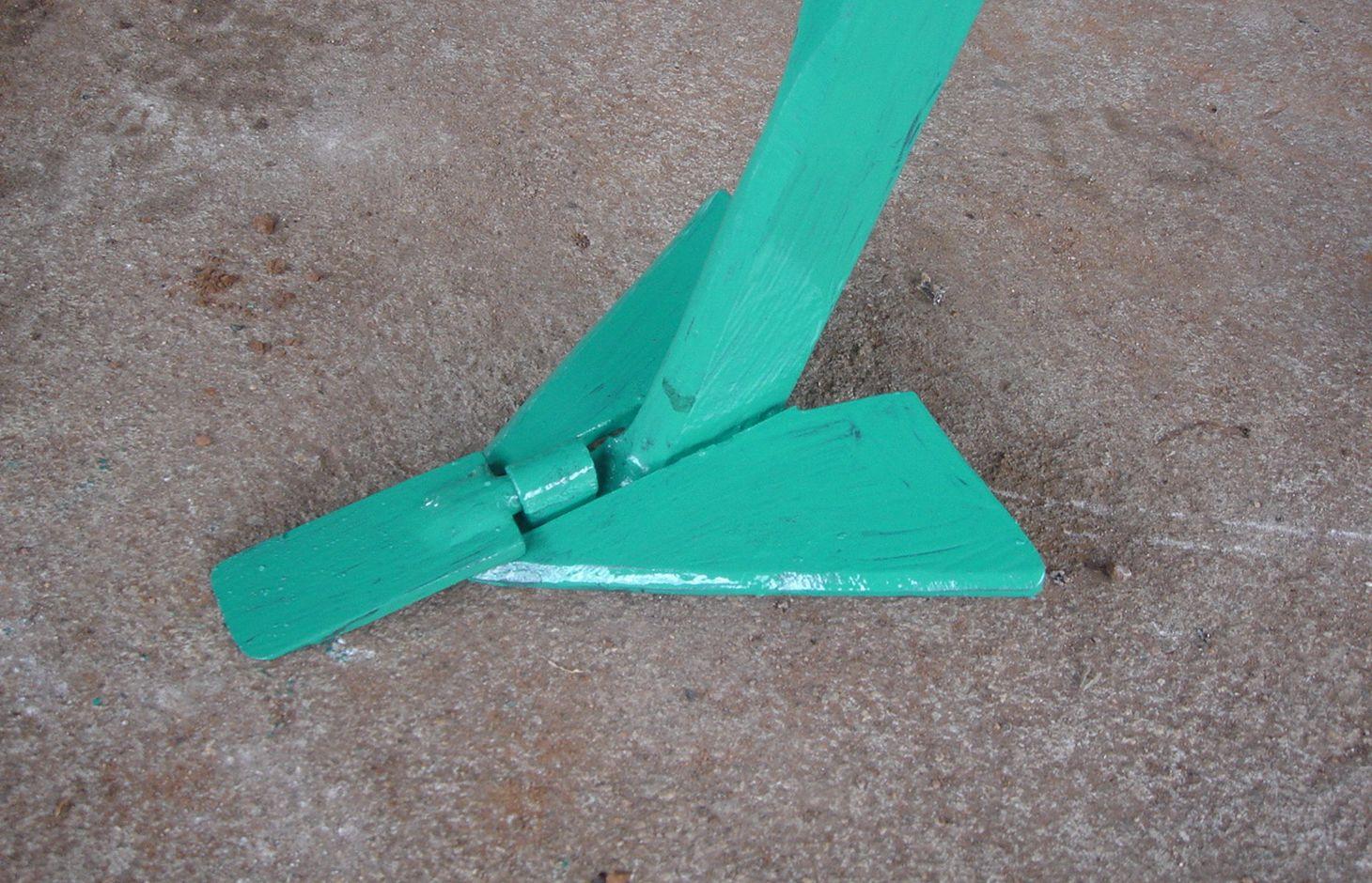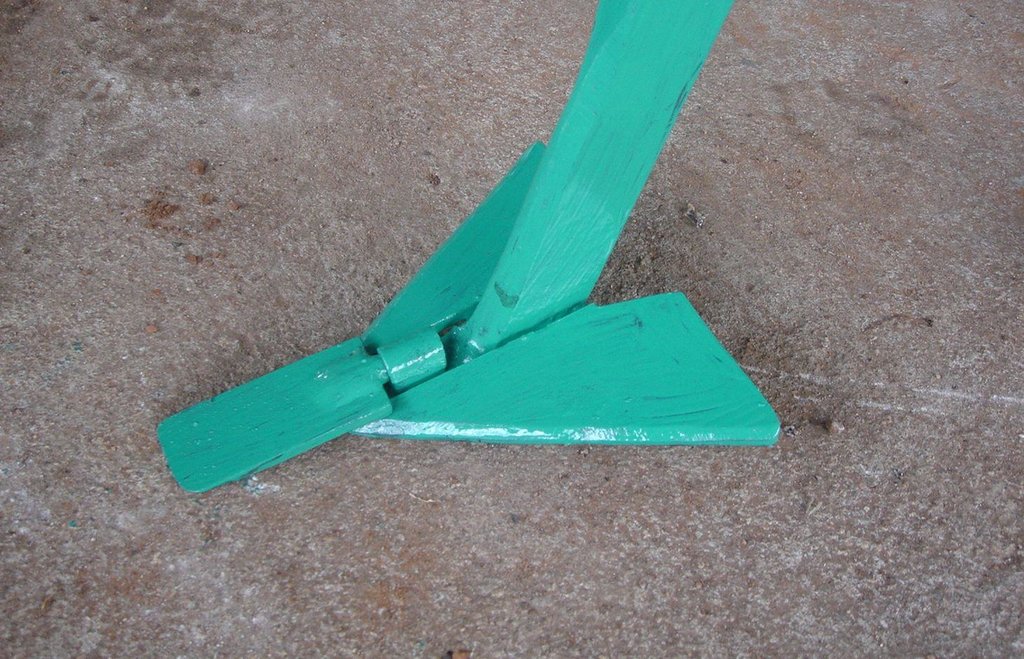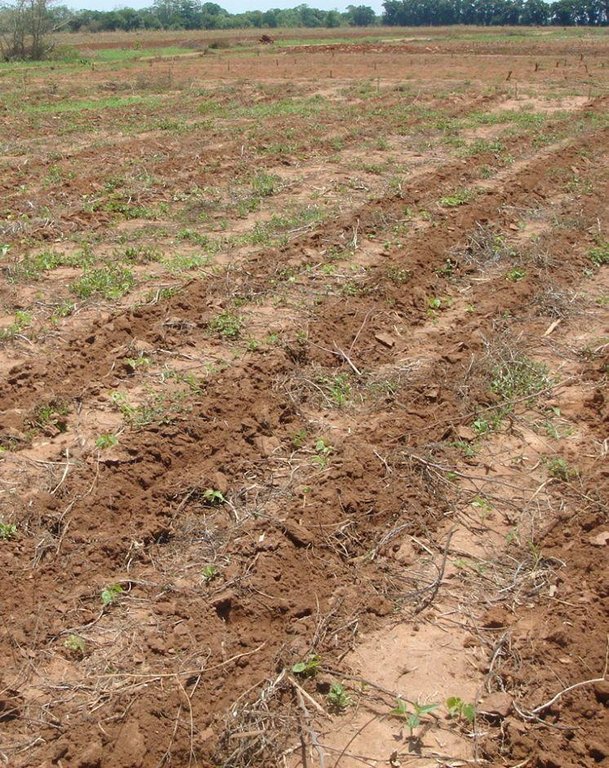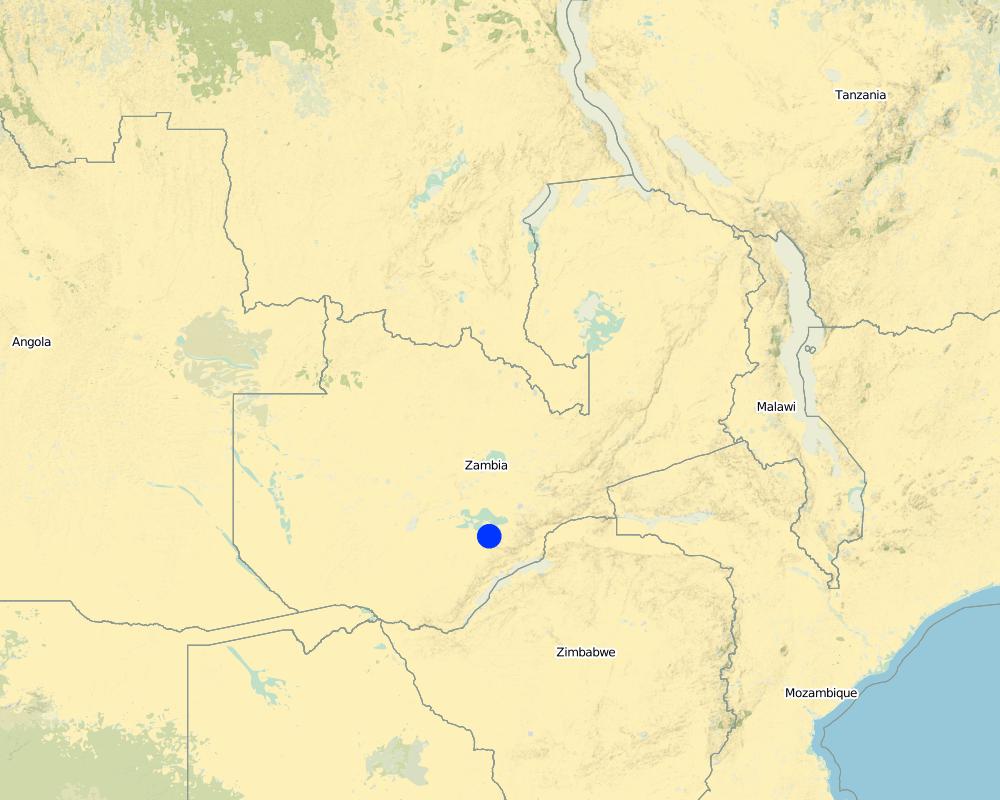Strip Tillage Conservation Farming [Zambia]
- Creation:
- Update:
- Compiler: Silenga Wamunyima
- Editor: –
- Reviewers: David Streiff, Alexandra Gavilano
technologies_1187 - Zambia
View sections
Expand all Collapse all1. General information
1.2 Contact details of resource persons and institutions involved in the assessment and documentation of the Technology
Key resource person(s)
SLM specialist:
SLM specialist:
Ndandula Sharon
Golden Valley Agricultural Research Trust
Zambia
SLM specialist:
Katoweji Alfred
Golden Valley Agricultural Research Trust
Zambia
SLM specialist:
1.3 Conditions regarding the use of data documented through WOCAT
The compiler and key resource person(s) accept the conditions regarding the use of data documented through WOCAT:
Yes
1.5 Reference to Questionnaire(s) on SLM Approaches (documented using WOCAT)
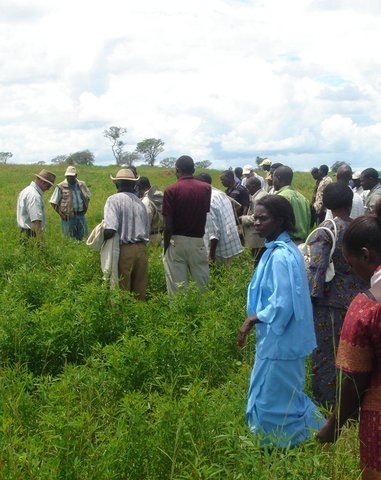
Participatory Research and Development [Zambia]
This is a collaborative process between researchers and farmers for developing and adapting new technologies that focus on incorporating the perspectives and inputs from the farmers into the development process.
- Compiler: Arthur Chomba
2. Description of the SLM Technology
2.1 Short description of the Technology
Definition of the Technology:
Strip Tillage Conservation Farming is an animal draft reduced tillage method that involves loosening a strip of soil with a strip tillage tool so as to reduce soil disturbance and improve soil and water conservation.
2.2 Detailed description of the Technology
Description:
The strip tillage tool is an adaptation of a Magoye Ripper but is meant to be used in moist soil. In the strip tillage tool, sub-surface wings are attached to the ripper tine to increase the width of soil disruption which the ripper will be unable to achieve in moist soil. The sub-surface wings loosen the soil by lifting it slightly and letting it fall in place without inverting it. In this way, a strip of soil with a width of around 20cm is tilled up to 20cm deep and this is where the crop will be planted. The region between the strips is maintained as a no-till region for soil and water conservation.
Purpose of the Technology: The strip tillage tool is meant to be a transitional technology for farmers intending to adopt Conservation Agriculture (CA) in degraded soils. These soils will need routine loosening while the biological activities allow the soil structure to recover sufficiently until tillage is no longer required. Strip tillage is able to achieve deeper soil loosening with much less draft force, wear of tines and soil disturbance than ripping. The untilled region between the strips enables the benefits of soil cover such as improved infiltration, soil water storage and increased soil organic matter. Soil loosening by strip tillage does not produce large clods like ripping does but instead produces a fine seedbed that enables uniform emergence of the crop, and this together with the deep penetration results in early plant vigour. The strip tillage implement is also designed to allow the attachment of a planter unit to enable tillage and planting in one operation.
Establishment / maintenance activities and inputs: The establishment of strip tillage based conservation agriculture mainly involves the purchase of the strip tillage implement and the replaceable tines. Liming acidic soils (low pH soils) followed by a final ploughing will be required to correct the soil PH which otherwise will be difficult to correct once conservation tillage has been established. Maintenance activities include strip-tilling the soil which may or may not include planting and fertilizing in the same operation. Weeding should preferably include the use of herbicides, implying that the major operations will include spraying. In addition to the normal conventional inputs, herbicides will also become a major input and cost.
Natural / human environment: The strip tillage technology is most suited to the bigger small-scale farmers with a capacity of 5ha to about 20ha. The strip tillage tool together with the planter will require a relatively substantial investment and only the bigger farmers will fully utilize its capacity. The strip tillage action will not be very effective in wet soils especially in the heavier soils, soil disruption is best achieved when the soil is slightly moist but not too dry as to require to high draft forces. Strip tillage is useful in soil with poor structure that will require routine loosening to maintain yields while the soil is being rehabilitated.
2.3 Photos of the Technology
2.5 Country/ region/ locations where the Technology has been applied and which are covered by this assessment
Country:
Zambia
Region/ State/ Province:
Zambia/Southern Province
Further specification of location:
Mazabuka/Magoye
Specify the spread of the Technology:
- evenly spread over an area
If precise area is not known, indicate approximate area covered:
- 0.1-1 km2
Comments:
The strip tillage technology is only in its second year of promotion and 7 farmers had adopted the technology in the 2011/12 season. The field sizes range from 1ha to 30ha.
Map
×2.6 Date of implementation
If precise year is not known, indicate approximate date:
- less than 10 years ago (recently)
2.7 Introduction of the Technology
Specify how the Technology was introduced:
- during experiments/ research
Comments (type of project, etc.):
Development of the strip tillage technology began in 2008 in response to farmers’ feedback from the promotion of another conservation agricultural technology, the Magoye Ripper. The technology was introduced to the farmers in 2011.
3. Classification of the SLM Technology
3.1 Main purpose(s) of the Technology
- reduce, prevent, restore land degradation
3.2 Current land use type(s) where the Technology is applied
Land use mixed within the same land unit:
Yes
Specify mixed land use (crops/ grazing/ trees):
- Agro-pastoralism (incl. integrated crop-livestock)

Cropland
- Annual cropping
Annual cropping - Specify crops:
- cereals - maize
- fibre crops - cotton
- oilseed crops - groundnuts
Number of growing seasons per year:
- 1
Specify:
Longest growing period in days: 135; Longest growing period from month to month: Mid November to end of March

Grazing land
Animal type:
- cattle - dairy
- goats
- poultry

Forest/ woodlands
Comments:
Livestock density (if relevant):
1-10 LU /km2
Principaux problèmes d'utilisation des sols (opinion du compilateur): perte de structure du sol et perte de fertilité du sol
Principaux problèmes d'utilisation des terres (perception des utilisateurs fonciers): sécheresses et périodes de sécheresse
L'élevage pèche sur les résidus de récoltes
3.4 Water supply
Water supply for the land on which the Technology is applied:
- rainfed
3.5 SLM group to which the Technology belongs
- minimal soil disturbance
3.6 SLM measures comprising the Technology

agronomic measures
- A2: Organic matter/ soil fertility
- A3: Soil surface treatment
- A6: Residue management
- A7: Others
A3: Differentiate tillage systems:
A 3.1: No tillage
A6: Specify residue management:
A 6.1: burned
Comments:
Specification of other agronomic measures: Zero till, Crop Residue
Type of agronomic measures: early planting, mulching, manure / compost / residues, mineral (inorganic) fertilizers, soil conditioners (lime, gypsum), rotations / fallows, breaking compacted topsoil, minimum tillage, non-inversion tillage, breaking compacted subsoil
3.7 Main types of land degradation addressed by the Technology

soil erosion by water
- Wt: loss of topsoil/ surface erosion

chemical soil deterioration
- Cn: fertility decline and reduced organic matter content (not caused by erosion)

physical soil deterioration
- Pc: compaction
- Pk: slaking and crusting
- Pi: soil sealing

biological degradation
- Bl: loss of soil life
Comments:
Secondary types of degradation addressed: Wt: loss of topsoil / surface erosion
Main causes of degradation: soil management (over ploughing, soil nutrient mining), crop management (annual, perennial, tree/shrub) (Monocropping of Maize), overgrazing (overgrazing of crop residues), poverty / wealth (Charcoal burning, under application of fertilizer)
Secondary causes of degradation: deforestation / removal of natural vegetation (incl. forest fires) (charcoal burning, openning up new land for agriculture), Heavy / extreme rainfall (intensity/amounts) (high intensity storms resulting in soil erosion and leaching), land tenure (over-exploitation of communal land), governance / institutional (lack of credit facilities)
3.8 Prevention, reduction, or restoration of land degradation
Specify the goal of the Technology with regard to land degradation:
- reduce land degradation
- restore/ rehabilitate severely degraded land
Comments:
Secondary goals: prevention of land degradation
4. Technical specifications, implementation activities, inputs, and costs
4.1 Technical drawing of the Technology
Technical specifications (related to technical drawing):
Planting lines are done at a depth of 15-20cm with inter row of 75 or 90cm. The width of the open furrow is 5-10cm wide. Planting rows are done across the slope to reduce runoff, these planting rows may be made in the dry season or during the rainy season when the soil is moist.
Location: Magoye. Mazabuka/Southern Province/Zambia
Date: 2014-06-29
Technical knowledge required for field staff / advisors: high (must be able to troubleshoot and advise the farmers on how to adapt the technology to fit into their production systems.)
Technical knowledge required for land users: moderate (knowledge of soil health management required when adopting the practice)
Main technical functions: control of raindrop splash, improvement of ground cover, improvement of topsoil structure (compaction), improvement of subsoil structure (hardpan), increase in organic matter, increase of infiltration, increase / maintain water stored in soil
Secondary technical functions: improvement of surface structure (crusting, sealing), increase in nutrient availability (supply, recycling,…), increase of groundwater level / recharge of groundwater, water harvesting / increase water supply
Early planting
Material/ species: Maize, Cotton
Quantity/ density: 44,000 pla
Remarks: 25cm intra row x 75cm
Mulching
Material/ species: Crop residues
Quantity/ density: 3ton/ha
Remarks: Uniformly spread
Manure / compost / residues
Material/ species: crop residues
Quantity/ density: 3ton/ha
Remarks: uniformly spread
Mineral (inorganic) fertilizers
Material/ species: basal and top dressing
Quantity/ density: 800kg/ha
Remarks: spot application
Soil conditioners (lime, gypsum)
Material/ species: lime
Quantity/ density: 1ton/ha
Remarks: every 2-3 years
Rotations / fallows
Material/ species: rotations of maize, cotton, cowpeas
Breaking compacted topsoil
Material/ species: strip tillage
Quantity/ density: 20cm deep
Minimum tillage
Material/ species: strip tillage
Non-inversion tillage
Material/ species: strip tillage
Breaking compacted subsoil
Material/ species: strip tillage
Author:
Silenga Wamunyima, Box 670577, Mazabuka, Zambia
4.2 General information regarding the calculation of inputs and costs
Specify currency used for cost calculations:
- USD
Indicate average wage cost of hired labour per day:
2.40
4.3 Establishment activities
| Activity | Timing (season) | |
|---|---|---|
| 1. | Strip Tillage implement | |
| 2. | Knapsack Sprayer |
4.4 Costs and inputs needed for establishment
| Specify input | Unit | Quantity | Costs per Unit | Total costs per input | % of costs borne by land users | |
|---|---|---|---|---|---|---|
| Equipment | Strip Tillage implement | pieces | 1.0 | 500.0 | 500.0 | 100.0 |
| Equipment | Knapsack Sprayer | pieces | 1.0 | 80.0 | 80.0 | 100.0 |
| Total costs for establishment of the Technology | 580.0 | |||||
| Total costs for establishment of the Technology in USD | 580.0 | |||||
Comments:
Duration of establishment phase: 2 month(s)
4.5 Maintenance/ recurrent activities
| Activity | Timing/ frequency | |
|---|---|---|
| 1. | Slashing and spreading crop residues | May-June yearly after harvest |
| 2. | Liming soil | Nov-Dec every 3 years |
| 3. | strip tillage, planting and fertilizing | Nov-Dec at onset of rain |
| 4. | Chemical weeding | 3 times per season |
| 5. | Harvesting | April-May |
4.6 Costs and inputs needed for maintenance/ recurrent activities (per year)
| Specify input | Unit | Quantity | Costs per Unit | Total costs per input | % of costs borne by land users | |
|---|---|---|---|---|---|---|
| Labour | Slashing and spreading crop residues | persons/day/ha | 8.0 | 2.5 | 20.0 | 100.0 |
| Labour | Liming soil | persons/day/ha | 2.0 | 2.5 | 5.0 | 100.0 |
| Labour | Strip tillage, planting and fertilizing | persons/day/ha | 4.0 | 2.5 | 10.0 | 100.0 |
| Labour | Chemical weeding (sprayers) | persons/day/ha | 24.0 | 1.0 | 24.0 | 100.0 |
| Equipment | Animal traction | ha | 1.0 | 40.0 | 40.0 | 100.0 |
| Plant material | Seeds | kg/ha | 20.0 | 2.5 | 50.0 | 100.0 |
| Fertilizers and biocides | Fertilizer | kg/ha | 400.0 | 0.8 | 320.0 | 100.0 |
| Fertilizers and biocides | Herbicides | l/ha | 5.0 | 6.0 | 30.0 | 100.0 |
| Construction material | Lime | kg | 1000.0 | 0.042 | 42.0 | 100.0 |
| Other | Labour: Chemical weeding (sprayers) | persons/day/ha | 10.0 | 4.0 | 40.0 | 100.0 |
| Other | Labour: Harvesting | persons/day/ha | 10.0 | 4.0 | 40.0 | 100.0 |
| Total costs for maintenance of the Technology | 621.0 | |||||
| Total costs for maintenance of the Technology in USD | 621.0 | |||||
Comments:
Machinery/ tools: Strip tillage planter
Calculations are for 1 ha of maize under strip tillage based conservation tillage and costs are for the Zambia situation in Magoye as of August 2012.
4.7 Most important factors affecting the costs
Describe the most determinate factors affecting the costs:
The weed control method employed is the main determinate factor depending on whether the farmer uses hand hoe or herbicides for weeding. Weed densities are higher in unploughed fields increasing the labour requirements/costs by a factor of about 5 if hand weeding is used instead of herbicides. Another major recurrent cost is that of fertilizer which makes up about half the cost hence the total cost will vary significantly depending on fertilizer cost.
5. Natural and human environment
5.1 Climate
Annual rainfall
- < 250 mm
- 251-500 mm
- 501-750 mm
- 751-1,000 mm
- 1,001-1,500 mm
- 1,501-2,000 mm
- 2,001-3,000 mm
- 3,001-4,000 mm
- > 4,000 mm
Specifications/ comments on rainfall:
Summer rains from November to March
Agro-climatic zone
- semi-arid
Thermal climate class: subtropics. 3 distinct seasons – summer, winter and one rainy season
5.2 Topography
Slopes on average:
- flat (0-2%)
- gentle (3-5%)
- moderate (6-10%)
- rolling (11-15%)
- hilly (16-30%)
- steep (31-60%)
- very steep (>60%)
Landforms:
- plateau/plains
- ridges
- mountain slopes
- hill slopes
- footslopes
- valley floors
Altitudinal zone:
- 0-100 m a.s.l.
- 101-500 m a.s.l.
- 501-1,000 m a.s.l.
- 1,001-1,500 m a.s.l.
- 1,501-2,000 m a.s.l.
- 2,001-2,500 m a.s.l.
- 2,501-3,000 m a.s.l.
- 3,001-4,000 m a.s.l.
- > 4,000 m a.s.l.
5.3 Soils
Soil depth on average:
- very shallow (0-20 cm)
- shallow (21-50 cm)
- moderately deep (51-80 cm)
- deep (81-120 cm)
- very deep (> 120 cm)
Soil texture (topsoil):
- medium (loamy, silty)
- fine/ heavy (clay)
Topsoil organic matter:
- low (<1%)
If available, attach full soil description or specify the available information, e.g. soil type, soil PH/ acidity, Cation Exchange Capacity, nitrogen, salinity etc.
Soil fertility is low - medium and low fertility caused mainly by poor soil management practices, otherwise soils are inherently fertile.
Topsoil organic matter: Due to excessive ploughing and under fertilization
Soil drainage / infiltration is good - medium. Soils are naturally well drained but become less so after compaction due to ploughing
Soil water storage capacity is medium. Soils mostly loam to sandy loam with medium storage capacity
5.4 Water availability and quality
Ground water table:
> 50 m
Availability of surface water:
medium
Water quality (untreated):
poor drinking water (treatment required)
Comments and further specifications on water quality and quantity:
Ground water table: Hand wells are <20m but reliable boreholes are > 50m
Availability of surface water: Mostly seasonal streams and dams
Water quality (untreated):Good when from communal hand-pumps and poor when from hand-dug wells.
5.5 Biodiversity
Species diversity:
- medium
5.6 Characteristics of land users applying the Technology
Market orientation of production system:
- subsistence (self-supply)
- mixed (subsistence/ commercial)
Off-farm income:
- 10-50% of all income
Relative level of wealth:
- very poor
- poor
Individuals or groups:
- individual/ household
Level of mechanization:
- manual work
- animal traction
Gender:
- men
Indicate other relevant characteristics of the land users:
Land users applying the Technology are mainly common / average land users
Difference in the involvement of women and men: The technology is applied mostly by men since most households are headed males and animal traction operation are reserved for men. Planting and weeding operations are the domain of women and children
Population density: 10-50 persons/km2
Annual population growth: 3% - 4%
8% of the land users are rich and own 15% of the land (own more than 10 cattle).
8% of the land users are average wealthy and own 15% of the land (own 5 - 10 cattle).
16% of the land users are poor and own 20% of the land (less than 5 cattle).
68% of the land users are poor and own 40% of the land (do not own cattle).
Off-farm income specification: sale of rainfed crops makes up about half of their income, the remainder coming from sale of livestock, petty trading, hiring out labour and remittances
Market orientation of production system: Livestock, maize and legumes for home consumption/subsistence and sale of excess maize and cotton, dairy products (mixed).
Level of mechanization: Manual labour only for small backyard fields. Families without cattle borrow or hire
5.7 Average area of land used by land users applying the Technology
- < 0.5 ha
- 0.5-1 ha
- 1-2 ha
- 2-5 ha
- 5-15 ha
- 15-50 ha
- 50-100 ha
- 100-500 ha
- 500-1,000 ha
- 1,000-10,000 ha
- > 10,000 ha
Is this considered small-, medium- or large-scale (referring to local context)?
- small-scale
Comments:
Cropland: 1-2 ha (families without oxen), 2-5 ha (families with one pair of oxen), 5-15 ha (families with over five oxen)
Grazing land: 5-15 ha, 15-50 ha, 50-100 ha
5.8 Land ownership, land use rights, and water use rights
Land ownership:
- communal/ village
- individual, not titled
Land use rights:
- open access (unorganized)
- individual
- Apportioned by traditional rulers
Water use rights:
- open access (unorganized)
- Apportioned by traditional rulers
5.9 Access to services and infrastructure
health:
- poor
- moderate
- good
education:
- poor
- moderate
- good
technical assistance:
- poor
- moderate
- good
employment (e.g. off-farm):
- poor
- moderate
- good
markets:
- poor
- moderate
- good
energy:
- poor
- moderate
- good
roads and transport:
- poor
- moderate
- good
drinking water and sanitation:
- poor
- moderate
- good
financial services:
- poor
- moderate
- good
6. Impacts and concluding statements
6.1 On-site impacts the Technology has shown
Socio-economic impacts
Production
crop production
Quantity before SLM:
3tons/ha
Quantity after SLM:
5tons/ha
Comments/ specify:
Due to early planting
fodder production
Comments/ specify:
Residues needed for soil cover
risk of production failure
Comments/ specify:
Better resistance
production area
Quantity before SLM:
2-3ha
Quantity after SLM:
>10ha
Income and costs
farm income
Comments/ specify:
Due to increased production area and improved yield
diversity of income sources
Comments/ specify:
More time and labour freed for other activities
workload
Comments/ specify:
Due to mechanised planting and herbicide use
Socio-cultural impacts
food security/ self-sufficiency
Comments/ specify:
Due to incresed yields
health situation
Comments/ specify:
Improved nutrition due to crop diversification
recreational opportunities
Comments/ specify:
Less time spent on farm operations
community institutions
Comments/ specify:
Farmers trained through cooperatives
SLM/ land degradation knowledge
Comments/ specify:
Due to incresed soil Carbon, crop residues to reduce run off, and capacity building
conflict mitigation
Comments/ specify:
Due to competition with neighbours cattle for crop residues
livelihood and human well-being
Comments/ specify:
The technology was only introduced recently and not yet widely adopted to make an impact. However the few farmers that have adopted have been able to multiply their production capacities and incomes.
Ecological impacts
Water cycle/ runoff
harvesting/ collection of water
Comments/ specify:
Due to better soil cover
surface runoff
Comments/ specify:
Due to better soil cover
excess water drainage
Comments/ specify:
Improved soil structure
groundwater table/ aquifer
Comments/ specify:
Due to good drainage
evaporation
Comments/ specify:
Due to better soil cover
Soil
soil moisture
Comments/ specify:
Due to better soil cover
soil cover
Comments/ specify:
Due to non-inversion tillage
soil loss
Comments/ specify:
Due to minimum soil disturbance, soil cover
soil crusting/ sealing
Comments/ specify:
Due to minimum soil disturbance, soil cover
soil compaction
Comments/ specify:
Due to deep tillage
nutrient cycling/ recharge
Comments/ specify:
Due to minimum soil disturbance, soil cover
salinity
Comments/ specify:
Due to good drainage
soil organic matter/ below ground C
Comments/ specify:
Due to minimum soil disturbance, soil cover
Biodiversity: vegetation, animals
biomass/ above ground C
Comments/ specify:
Due to minimum soil disturbance, soil cover
animal diversity
Comments/ specify:
Due to soil organic matter (SOM) buildup
pest/ disease control
Comments/ specify:
Resistance to chemical weed control
Climate and disaster risk reduction
emission of carbon and greenhouse gases
Comments/ specify:
Due to Carbon (C) sequestration
Other ecological impacts
Ground water contamination
Comments/ specify:
Some chemicals get carried down the profile
6.2 Off-site impacts the Technology has shown
water availability
Comments/ specify:
Only if applied over an extensive area
reliable and stable stream flows in dry season
Comments/ specify:
Only if applied over an extensive area
downstream flooding
Comments/ specify:
Only if applied over an extensive area
downstream siltation
Comments/ specify:
Only if applied over an extensive area
damage on neighbours' fields
6.3 Exposure and sensitivity of the Technology to gradual climate change and climate-related extremes/ disasters (as perceived by land users)
Gradual climate change
Gradual climate change
| Season | increase or decrease | How does the Technology cope with it? | |
|---|---|---|---|
| annual temperature | increase | not known |
Climate-related extremes (disasters)
Meteorological disasters
| How does the Technology cope with it? | |
|---|---|
| local rainstorm | well |
| local windstorm | not known |
Climatological disasters
| How does the Technology cope with it? | |
|---|---|
| drought | well |
Hydrological disasters
| How does the Technology cope with it? | |
|---|---|
| general (river) flood | not well |
Other climate-related consequences
Other climate-related consequences
| How does the Technology cope with it? | |
|---|---|
| reduced growing period | not known |
6.4 Cost-benefit analysis
How do the benefits compare with the establishment costs (from land users’ perspective)?
Short-term returns:
positive
Long-term returns:
very positive
How do the benefits compare with the maintenance/ recurrent costs (from land users' perspective)?
Short-term returns:
positive
Long-term returns:
very positive
Comments:
Timely and quicker planting enables larger areas to be planted and with less labour in the short term. Improved soil structure and soil fertility leads to higher yields and better resilience to droughts in the long term.
6.5 Adoption of the Technology
- > 50%
If available, quantify (no. of households and/ or area covered):
7 households in an area of 0.1 - 1 km2 (field size 1 ha - 30 ha)
Of all those who have adopted the Technology, how many did so spontaneously, i.e. without receiving any material incentives/ payments?
- 91-100%
Comments:
7 land user families have adopted the Technology without any external material support
Comments on spontaneous adoption: These farmers heard of the technology by word of mouth and solicited for the technology even before it could be officially promoted
There is a strong trend towards spontaneous adoption of the Technology
Comments on adoption trend: Even before promotion, inquiries to purchase the strip planter have been overwhelming. This is most likely due to the ability to till, plant and fertilizer in one operation.
6.7 Strengths/ advantages/ opportunities of the Technology
| Strengths/ advantages/ opportunities in the land user’s view |
|---|
|
Enables early planting How can they be sustained / enhanced? acquire more than one strip tillage implement |
|
Quicker planting enables planting of larger areas How can they be sustained / enhanced? Plant the seed and apply the fertilizer in one opperation |
|
Lighter to pull enabling deeper penetration of the tillage tool increasing the rooting depth How can they be sustained / enhanced? Use in moist soils |
| Strengths/ advantages/ opportunities in the compiler’s or other key resource person’s view |
|---|
|
Enables early planting How can they be sustained / enhanced? Plant with the first heavy rain in November |
|
Quicker planting enables planting of larger areas How can they be sustained / enhanced? Use herbicides because without them, the capacity to weed will limit the production capacity |
|
Preserves soil cover and reduces soil disturbance How can they be sustained / enhanced? Training in residue management (No Burning) and use of zero tillage implement |
6.8 Weaknesses/ disadvantages/ risks of the Technology and ways of overcoming them
| Weaknesses/ disadvantages/ risks in the land user’s view | How can they be overcome? |
|---|---|
| The purchase price of the strip tillage planter | subsidizing the strip tillage implement |
| Excessive weeds and lack of information on herbicide use | More training on herbicide use |
| Weaknesses/ disadvantages/ risks in the compiler’s or other key resource person’s view | How can they be overcome? |
|---|---|
| The purchase price is high making it affordable only to the larger small-scale farmers | It is already by far the cheapest planter available but mass production can lead to significant reduction in purchase price |
| Benefits are more evident on a scale larger than many farmers capacity especially when used in combination with herbicides | Support farmers to increase capacity |
| Difficult to control weeds in the absence of herbicides | make herbicides more available at a lower cost |
7. References and links
7.1 Methods/ sources of information
7.2 References to available publications
Title, author, year, ISBN:
Social-economic analysis of conservation agriculture in southern Africa, FAO, 2011
Available from where? Costs?
FAO
Title, author, year, ISBN:
Conservation farming in Zambia, Steven Haggblade, Gelson Tembo, October 2003
Available from where? Costs?
INDABA project, Michigan State University
7.3 Links to relevant online information
Title/ description:
Conservation farming in Zambia, Conservation farming unit (CFU), 2011
URL:
cfu@zamnet.zm
Links and modules
Expand all Collapse allLinks

Participatory Research and Development [Zambia]
This is a collaborative process between researchers and farmers for developing and adapting new technologies that focus on incorporating the perspectives and inputs from the farmers into the development process.
- Compiler: Arthur Chomba
Modules
No modules


